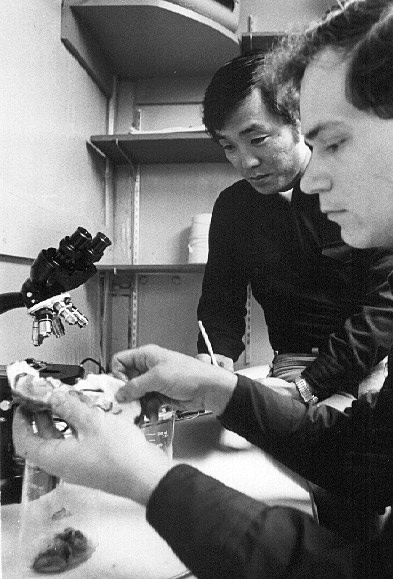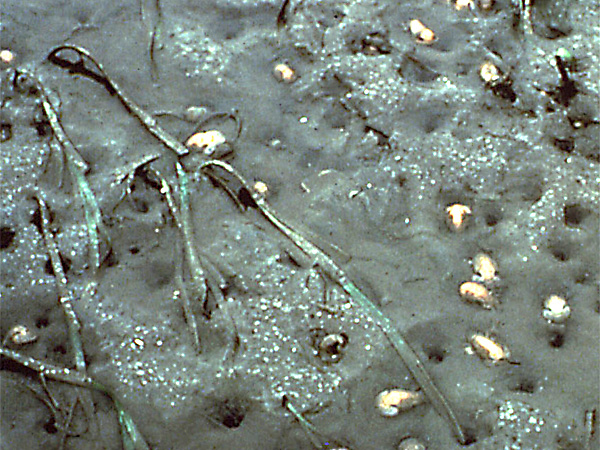
 Terry Nosho (center) at work in University of Washington oyster research lab. |
by Erica Goldman |
Washington state's oyster industry has been shaped by the dynamic interaction between problem-solving and entrepreneurship from its earliest years. Strong communication between university and industry has historically cultivated the breakthroughs that today make oyster culture a vibrant, sustainable industry. For Washington Sea Grant Program's aquaculture specialist Terry Nosho, "providing the linkage between university, government and industry is a full-time job." Nosho has spent 28 years forging and maintaining these connections. What kind of science has paved the way for the state's oyster industry? While the successful introduction of the Pacific oyster from Japan was serendipitous, not scientific, establishing the introduced species as the base of a self-sustaining industry required years of careful research. |
|
|
Finding Seed Studies of the reproductive biology of the Pacific oyster in the 1930s and 1940s revealed the environmental cues that cause oysters to spawn and the conditions that cause their larvae to settle. These findings enabled the oyster industry, under the leadership of Cedric Lindsay of Washington's Point Whitney Shellfish Laboratory, to develop techniques for forecasting the annual setting of oyster seed. The industry thereby eliminated its sole dependence on seed imported from Japan. In spite of improved techniques for catching seed, seed shortages continued and farmers still had to rely on imports. After major seed failures in the 1970s, University of Washington shellfish biologist Kenneth Chew developed a procedure for remote setting. This procedure requires that hatcheries raise oyster larvae and sell them to farmers to 'grow-out' in their ponds. Chew's work demonstrated that cultch (bits of broken oyster shell) set out on the mud bottom will induce larvae to settle and grow. Remote setting gave oyster farmers an alternative to wild-caught seed and effectively ended seed shortages in the U.S. Surviving the Shrimp Seed shortages were only one of many challenges that the oyster industry faced between the 1950s and 1970s. The 1958 El Niño/Southern Oscillation Phenomenon brought a suite of mysterious problems, many of which still lack satisfactory explanations. The phenomenon induced a population explosion of burrowing ghost shrimp and mud shrimp. These shrimp form elaborate burrows in the substrate, causing oysters to suffocate or to sink into the sediment. Since 1963, the oyster industry has controlled these pests by the application of the pesticide carbaryl (SEVIN). While seemingly effective in controlling burrowing shrimp populations, carbaryl is a broad-spectrum pesticide. The use of carbaryl in estuaries has raised considerable environmental concern and has been the subject of extensive scientific research. The 1958 El Niño also heralded the onset of the elusive "summer mortality." In the early 1960s oyster deaths in excess of 70% were observed in several areas of Washington. Heavy summer losses were felt through the 1980s and, although seasonal mortalities have subsided in recent years, they have not disappeared. Despite many years of extensive research, scientists have yet to pinpoint a specific cause, beyond linking mortalities to physiologic stresses associated with reproduction. A New Breed In the 1980s, on a hunch that this link existed, Kenneth Chew wondered if a non-reproductive oyster would be more suited for summer survival. Even if these oysters were equally susceptible to mortalities, a "sexless" oyster would improve the historically lackluster summer market. Unlike ordinary oysters, the sexless specimens would not become runny, chalky, and full of sperm and eggs during the reproductive season. By the late 1980s, Chew had successfully mastered triploidy -- the creation of oysters with an extra (third) set of chromosomes. These shellfish are created by genetic manipulation during early development and are reproductively inactive, remaining plump and sweet during summer months. The jury is still out on whether triploid oysters are more likely to resist summer mortality. Regardless, triploid oysters have revolutionized the oyster industry. Today, about 80-90% of all jarred oysters produced are triploid. Bumps in the Road The oyster industry, although healthy and prospering, faces several lingering scientific challenges. Oyster-borne diseases that affect humans still crop up, although they are quickly diagnosed and carefully controlled. Paralytic Shellfish Poisoning (PSP), caused by an algal toxin and Vibrio parahaemolyticus, a bacterial pathogen, are two of the main culprits. There is continued scientific effort in controlling these. Environmental concerns such as declining water quality and the introduction of exotic plants and animals, including the cordgrass Spartina (which is destroying valuable oyster habitat), continually push industry and science to come up with new solutions. Environmental legislation, such as the Endangered Species Act and Sustainable Fisheries and Management Act, will challenge the industry to stay one step ahead of changes that will invariably affect estuaries and other essential coastal habitats for threatened and endangered strains of Pacific salmon. While the road ahead is still a little bumpy, Washington state's oyster industry has set a strong precedent for problem-solving and innovation that will guide it into the 21st century. "From day one, the industry has been competitive," explains Nosho. "Because the industry is competitive, there is a certain amount of entrepreneurship that needs nurturing. We've seen this happen throughout time in the oyster industry." Erica B. Goldman is earning her doctorate in zoology at the University of Washington and is a freelance writer. |
|
